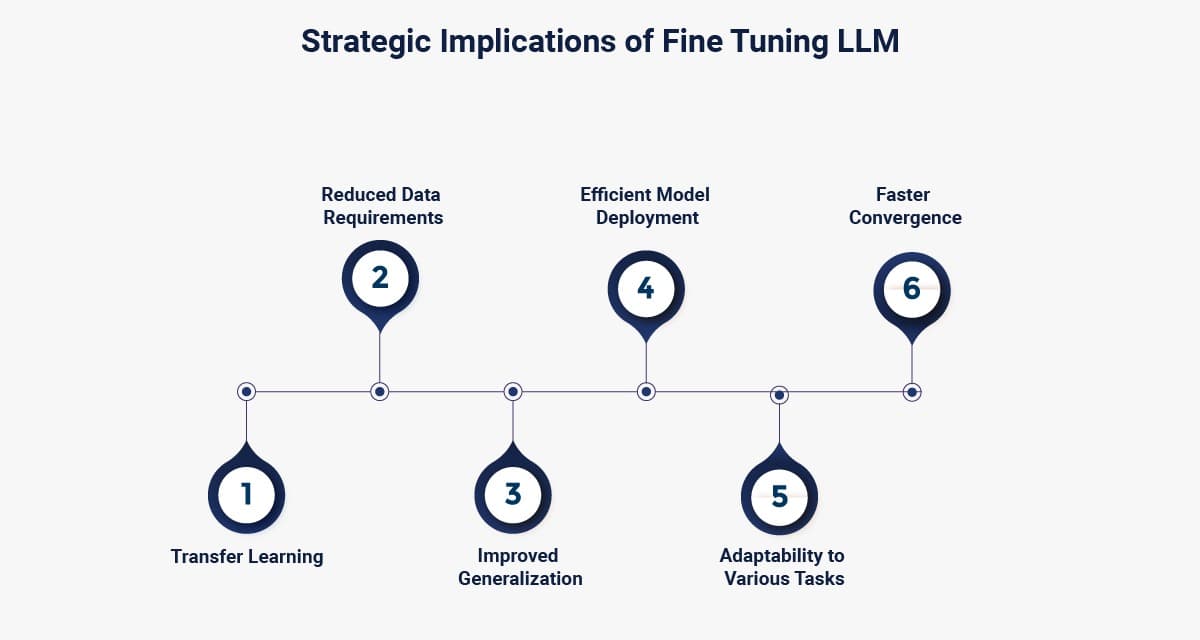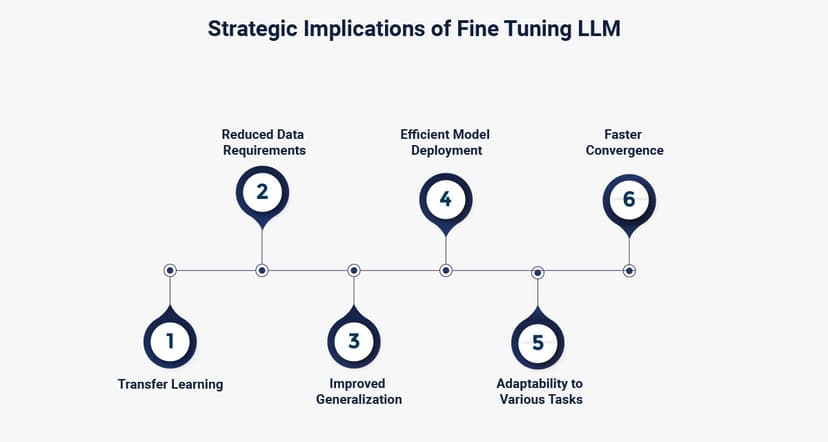Large Language Models (LLMs) like GPT-4 have revolutionized the field of artificial intelligence. These powerful tools can understand and generate human-like text, making them invaluable for various applications. However, to get the most out of these models, they often need to be fine-tuned for specific tasks. In this blog, we will explore the techniques, impact, and best practices for fine-tuning LLMs, making them more effective and efficient for your business needs.
Strategic Benefits of Fine-Tuning LLMs
1. Boosting Performance with Custom Models
Fine-tuning large language models means adjusting them to fit your specific needs. By doing this, the AI becomes more accurate and helpful in different situations. For example, if you’re in the healthcare industry, a fine-tuned model can better understand medical terminology and provide more relevant information.
2. Using Transfer Learning for Faster Results
Transfer learning uses pre-trained models as a starting point. This means you don’t have to start from scratch, saving time and effort. By building on what the model already knows, you can quickly fine-tune it to get great results, making the process both faster and more cost-effective.
3. Getting More with Less Data
Fine-tuning allows you to achieve high performance with a smaller amount of data. This is great for businesses that don’t have extensive data resources. Instead of needing millions of data points, you can refine the model with a smaller, more specific dataset and still get powerful AI tools.
4. Improving Versatility
A fine-tuned model can handle various tasks more effectively. It learns to generalize from the data it’s trained on, meaning it can perform well in different scenarios without needing extensive retraining. This versatility is valuable for businesses operating in multiple domains or dealing with different types of data.
5. Making Deployment Easier
Fine-tuning can make models lighter and faster, which helps in deploying them smoothly. This means your AI can run more efficiently, saving costs and improving user experience. For instance, a fine-tuned customer service chatbot can respond more quickly and accurately to customer queries.
6. Adapting to Different Tasks
Fine-tuned models are flexible and can be used for a wide range of tasks. Whether it’s customer service, content creation, or data analysis, these models can be customized to meet your specific needs. This adaptability ensures that businesses can leverage AI to address diverse challenges effectively.
7. Speeding Up Training
Fine-tuning helps models learn faster during training. This reduces the time and cost involved, allowing for quicker implementation and faster benefits. Businesses can deploy AI solutions more swiftly, gaining a competitive edge in their industry.

Core Applications of Fine-Tuning LLMs
1. Improving Customer Service
Fine-tuned models can greatly enhance customer service by providing accurate and relevant responses. This leads to better customer satisfaction and quicker resolution of issues. For example, a fine-tuned model can understand customer queries more precisely and provide more accurate answers.
2. Creating and Managing Content
Businesses can use fine-tuned models to generate high-quality content and manage editorial tasks. This automation helps save time and ensures consistency in your content. For instance, a fine-tuned model can draft blog posts, social media updates, or marketing materials with ease.
3. Gaining Insights from Data
Fine-tuning enables models to understand and analyze unstructured data, like text or speech, providing valuable insights for business decisions. By processing large volumes of text, businesses can uncover patterns and trends that inform their strategies, leading to more informed and effective decisions.
4. Personalizing Customer Experiences
Fine-tuned models can deliver personalized experiences on a large scale. They understand individual customer needs and preferences, enhancing engagement and loyalty. For example, a fine-tuned recommendation system can suggest products or services tailored to each customer’s interests.
Overcoming LLM Fine-Tuning Challenges
Fine-tuning large language models involves several challenges that can impact the effectiveness and efficiency of the process. Addressing these challenges requires strategic approaches to ensure optimal model performance and seamless deployment. Here are key challenges faced during fine-tuning and practical solutions to overcome them:
- Data Quality and Quantity Obtaining a high-quality, well-labeled dataset can be difficult and time-consuming, which can lead to suboptimal model performance. Focus on curating diverse and comprehensive datasets relevant to the specific task and employ data augmentation techniques, such as generating synthetic data or using data transformation methods, to enhance the dataset and improve model robustness.
- Computational Resources Fine-tuning LLMs demands substantial computational power, often leading to high costs and extended training times. Leveraging cloud-based solutions or dedicated high-performance hardware can help manage these demands efficiently. Additionally, using distributed computing and parallel processing can speed up training and reduce overall resource consumption.
- Overfitting A common issue is overfitting, where the model performs well on training data but poorly on unseen data. Mitigate this by implementing dropout, which randomly drops neurons during training to prevent over-reliance on specific features. Early stopping can also be effective, halting training when performance on a validation set starts to degrade. Additionally, selectively freezing certain layers allows the model to retain general knowledge while focusing on learning task-specific features in the later layers.
- Hyperparameter Tuning Finding the right hyperparameters, such as learning rate, batch size, and the number of epochs, can be challenging due to the need for extensive experimentation. Automated hyperparameter optimization tools, such as grid search or Bayesian optimization, can streamline this process by systematically exploring different parameter settings and identifying the best configuration.
- Model Evaluation Ensuring the model generalizes well to new data involves using a validation set to monitor key metrics such as accuracy, precision, recall, and loss throughout the fine-tuning process. Continuous evaluation allows for the identification of potential issues early on and enables adjustments to the model or training parameters as needed.
- Deployment Challenges Deployment must be addressed to ensure the fine-tuned model performs reliably in real-world applications. Optimize the model for scalability to handle varying loads and ensure it integrates seamlessly with existing systems. Implement robust security measures to protect the model and the data it processes. Additionally, monitoring the model’s performance post-deployment and making necessary adjustments ensures it continues to perform effectively over time.
Best Practices for Fine-Tuning LLMs
Fine-tuning large language models requires a systematic approach to ensure that the models achieve optimal performance and effectively adapt to specific tasks. The following best practices outline key steps and considerations that can enhance the fine-tuning process, from data preparation to model deployment. By following these guidelines, you can maximize the accuracy, efficiency, and applicability of your fine-tuned LLM.
1. Define Your Tasks
Defining the task you wish the LLM to perform is the foundational step of the LLM fine-tuning process. A well-defined task gives businesses directional clarity of how they want their AI application to operate and its perceived benefits. At the same time, it ensures that the model’s capabilities are aligned with the key goals and the benchmarks for performance measurement are clearly set up.
2. Use the Correct Pre-Trained Model
Utilizing pre-trained models to fine-tune LLMs is critical. This is how businesses use knowledge gathered from vast datasets, ensuring that the LLM doesn’t just start learning from scratch. This method is not just computationally efficient and time-saving but also allows fine-tuning models to concentrate on the domain-specific nuances, leading to better model performance in complex tasks.
3. Set Hyperparameters
Hyperparameters are the adjustable variables that play an important role in the LLM training journey. For businesses, batch size, learning rate, number of epochs, and weight decay act as key hyperparameters that need to be modified to find the best configuration for the task.
4. Evaluate Model Performance
Once the process of fine-tuning large language models is finished, the model’s performance should be assessed based on the test set. This provides an unbiased look into how well the model is performing on unseen data compared to the original expectations. Based on the evaluation metrics, teams should continuously refine the model to ensure that the improvement scale is maintained.
5. Try Multiple Data Formats
Depending on your task, multiple data formats can have varied impacts on the model’s efficiency. For example, if you are looking to accomplish a classification task, you can use a format that separates the prompt and its completion through a special token, like "prompt": "James##\n", "completion": " name\n###\n". It’s important to use formats that best suit the use case you are trying to accomplish.
6. Gather a Vast High-Quality Dataset
LLMs require a lot of data to perform their best. It’s important to have a diverse and representative dataset for fine-tuning. However, gathering and categorizing large datasets can be expensive and time-consuming. To address this, you can use synthetic data generation techniques to increase the variety and scale of your dataset. Ensure that the synthetic data is relevant and consistent with your tasks and domain, and free from noise or bias.
7. Fine-Tune Subsets
To measure the value that you are getting from a dataset, fine-tune the LLM on a subset of your current dataset and gradually increase the dataset size. This helps estimate the LLM’s learning curve and determine if it needs more data to become efficient and scalable.

Fine-Tuning LLM Models in Business – The Way Forward
The future of LLM fine-tuning lies in businesses diving deep into their AI plans. The more customization needed, the greater the focus should be on using fine-tuning models.
For expert guidance and solutions, partner with an experienced AI development company. An AI development firm can help you navigate the complexities of fine-tuning and ensure your AI models are tailored to your specific business needs. With the right AI developer, your business can fully leverage the power of fine-tuned LLMs for optimal results.
To determine if fine-tuning is right for your business, consider the following questions:
Frequently Asked Questions (FAQ)
1. How do you fine-tune a large language model?
To fine-tune a large language model, start by preparing a high-quality, task-specific dataset. Select a pre-trained model that matches your needs, configure the fine-tuning parameters (such as learning rate and epochs), and train the model on your dataset. Validate its performance and iterate as needed to optimize results.
2.How much data is needed for LLM fine-tuning?
The amount of data required for fine-tuning depends on the task's complexity and desired accuracy. Generally, a few thousand high-quality examples are sufficient, though more data can enhance performance and robustness.
3.How do you fine-tune an LLM with your own data?
To fine-tune an LLM with your own data, first clean and format your dataset. Select a suitable pre-trained model, set the fine-tuning parameters, and train the model using your data. Validate the results and iterate to achieve the best performance.









